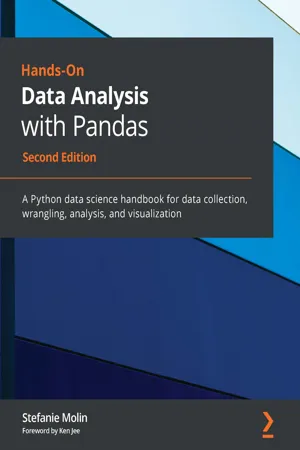
Hands-On Data Analysis with Pandas
A Python data science handbook for data collection, wrangling, analysis, and visualization, 2nd Edition
Stefanie Molin
- 788 Seiten
- English
- ePUB (handyfreundlich)
- Über iOS und Android verfügbar
Hands-On Data Analysis with Pandas
A Python data science handbook for data collection, wrangling, analysis, and visualization, 2nd Edition
Stefanie Molin
Über dieses Buch
Get to grips with pandas by working with real datasets and master data discovery, data manipulation, data preparation, and handling data for analytical tasks
Key Features
- Perform efficient data analysis and manipulation tasks using pandas 1.x
- Apply pandas to different real-world domains with the help of step-by-step examples
- Make the most of pandas as an effective data exploration tool
Book Description
Extracting valuable business insights is no longer a 'nice-to-have', but an essential skill for anyone who handles data in their enterprise. Hands-On Data Analysis with Pandas is here to help beginners and those who are migrating their skills into data science get up to speed in no time.This book will show you how to analyze your data, get started with machine learning, and work effectively with the Python libraries often used for data science, such as pandas, NumPy, matplotlib, seaborn, and scikit-learn.Using real-world datasets, you will learn how to use the pandas library to perform data wrangling to reshape, clean, and aggregate your data. Then, you will learn how to conduct exploratory data analysis by calculating summary statistics and visualizing the data to find patterns. In the concluding chapters, you will explore some applications of anomaly detection, regression, clustering, and classification using scikit-learn to make predictions based on past data.This updated edition will equip you with the skills you need to use pandas 1.x to efficiently perform various data manipulation tasks, reliably reproduce analyses, and visualize your data for effective decision making – valuable knowledge that can be applied across multiple domains.
What you will learn
- Understand how data analysts and scientists gather and analyze data
- Perform data analysis and data wrangling using Python
- Combine, group, and aggregate data from multiple sources
- Create data visualizations with pandas, matplotlib, and seaborn
- Apply machine learning algorithms to identify patterns and make predictions
- Use Python data science libraries to analyze real-world datasets
- Solve common data representation and analysis problems using pandas
- Build Python scripts, modules, and packages for reusable analysis code
Who this book is for
This book is for data science beginners, data analysts, and Python developers who want to explore each stage of data analysis and scientific computing using a wide range of datasets. Data scientists looking to implement pandas in their machine learning workflow will also find plenty of valuable know-how as they progress.You'll find it easier to follow along with this book if you have a working knowledge of the Python programming language, but a Python crash-course tutorial is provided in the code bundle for anyone who needs a refresher.
]]>
Häufig gestellte Fragen
Information
Section 1: Getting Started with Pandas
- Chapter 1, Introduction to Data Analysis
- Chapter 2, Working with Pandas DataFrames
Chapter 1: Introduction to Data Analysis
- The fundamentals of data analysis
- Statistical foundations
- Setting up a virtual environment
Chapter materials
- Download the ZIP file and extract the files locally.
- Clone the repository without forking it.
- Fork the repository and then clone it.
